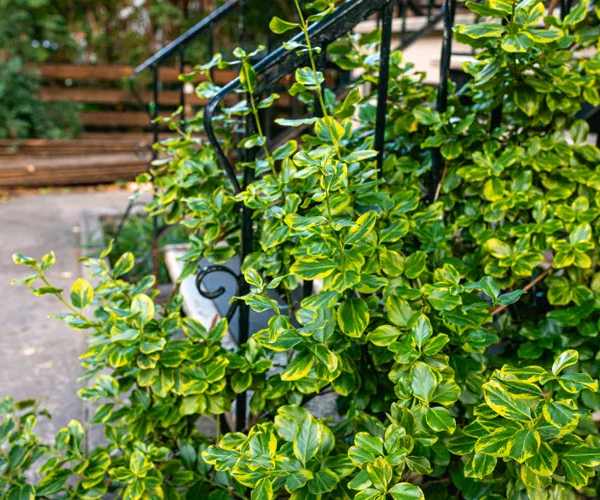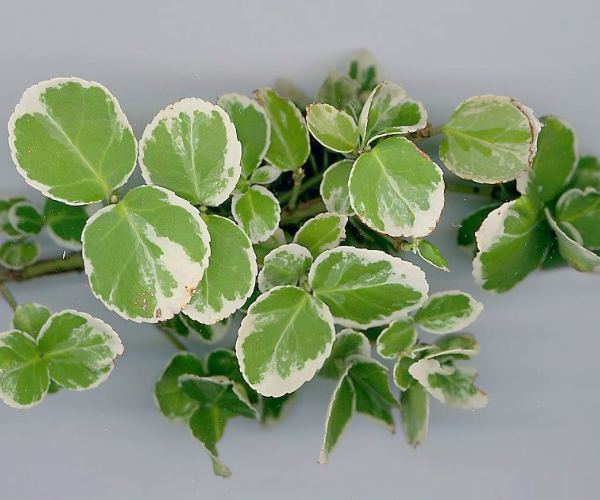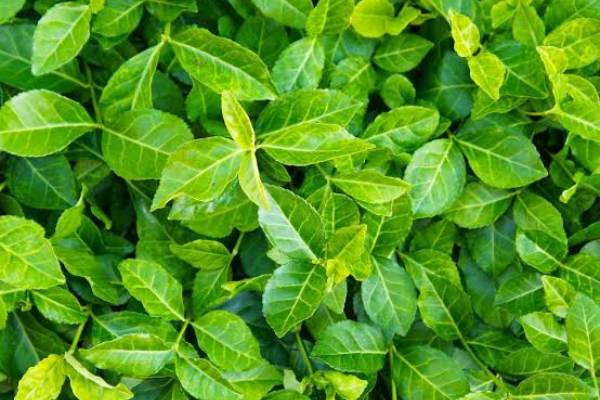Wintercreeper, also called Fortune’s spindle or climbing euonymus, is a broadleaf, evergreen shrub that is a climber or groundcover. People grow this beautiful plant for its foliage, with typical green-and-gold varieties that give classic color. This plant happily grows in most sun exposure and prefers moist soil, which also contributes to it being an aggressive spreader.
Just like other Euonymus species, this plant is also toxic to humans and pets.
Plant Attributes
- Common Name: Wintercreeper, Fortune’s spindle, climbing euonymus
- Botanical Name: Euonymus fortunei
- Family: Celastraceae
- Plant Type: Perennial, herbaceous, vine, shrub
- Mature Size: 14-32 ft. tall, 2-10 ft. wide
- Sun Exposure: Full, partial
- Soil Type: Well-drained
- Soil pH: Acidic, neutral, alkaline
- Hardiness Zones: 4-9 (USDA)
- Native Area: Asia
- Toxicity: Toxic to pets and animals
Wintercreeper Care
Wintercreeper is a versatile plant that acts as ground cover for both sunny and shady areas. It also serves as an edging plant along paths, as a slope cover, and as a foundation planting. Sometimes, they are also trained to climb like ivy to cover walls, fences, or chimneys.

Here are some maintenance requirements for growing wintercreeper:
- You can plant it anywhere besides in full shade.
- As long as the soil is not swampy, any type will work.
- While wintercreeper can tolerate dry soil, you still need to water it regularly.
- This plant doesn’t need fertilizer.
Light
Wintercreeper does extremely well in full sun to partial shade but it can not tolerate full shade.
Soil
This plant grows in average, medium moisture, well-drained soil. While it prefers alkaline soil, it will tolerate many different soil conditions, even compacted soil, slightly acidic to slightly alkaline pH between 6.0 to 8.0, as well as dry (and even drought) soil conditions. But, it doesn’t do well in wet soil.
Water
Only water the plant when the top three inches of the soil feel dry. Once established, the plant can tolerate drought conditions. If you live in a place where winters are extremely cold, you can help prevent some water problems like desiccation by watering the plants in the fall, before the ground freezes.
Temperature and Humidity
Wintercreeper euonymus thrives in all climatic conditions in USDA hardiness zones 4 through 9. In places where there are harsh winters, these plants can get affected by some winter damage from ice and extreme temperature drops. Luckily, this plant is resilient and is very good at recovering from the winter effects.
Fertilizer
This evergreen shrub with insignificant flowers does not normally need fertilizer. If you want, you can feed it fertilizer once a year in the fall, using a tiny amount of fertilizer applied at least two inches from the plant’s trunk.

Types of Wintercreeper
There are many famous cultivars of wintercreeper. Here are some:
- E. fortunei ‘Emerald Gaiety‘ has green and white leaves.
- E. fortunei ‘Emerald ‘n’ Gold‘ has green leaves with wide yellow margins. It can mound into a shrub of 4 to 5 feet in height.
- E. fortunei ‘Emerald Surprise‘ has green foliage with smaller yellow margins.
- E. fortunei ‘Silver Queen’ has silver or white-edged green leaves.
- E. fortunei ‘Sunspot’ features leaves with pronounced yellow centers.
- E. fortunei ‘Canadale Gold’ has glossy leaves with golden margins. It is a mounding form but is also good for vine training.
- E. fortunei ‘Minimus’ is a small mounding cultivar, growing to only about 18 inches but with a 6-foot spread. Known as “baby wintercreeper,” it has small leaves.
- E. fortunei ‘Colorata’ is a low-spreading cultivar, with leaves that have a purplish color on the undersides, therefore it is also known as purple-leaved wintercreeper.
Also, Read All You Need To Know About Polka Dot Plants Growth, Care, Tips, and More
Pruning
Pruning wintercreeper is usually done to either control its spread or keep it in a desired shape for instance, pruning it to keep it in a mounded shape rather than letting it spread as a ground cover. However, major pruning should be done after flowering is complete to deadhead flowers before they go to seed. Ensure that the cutting tools are sterilized after each cut.
How to propagate wintercreeper
You can easily propagate wintercreepr from new-growth cuttings in the spring. Here’s how:
- Using sterilized cutting shears, take a 4- to 6-inch length of stem that has at least a couple of leaves.
- Strip off the bottom pair of leaves and place the cutting in a moist potting mix.
- It is essential to keep the potting mix moist until roots that are at least an inch long emerge from the nodes where the leaves can be removed. After that, transplant the stem into a bigger pot.
- Harden off the plant before transplanting it into the garden.
Potting and repotting wintercreeper
If you’re thinking of growing wintercreeper in a container, choose a compact or dwarf variety and prune it nicely to control its massive growth. Select a container that is as large as a nursery container that has proper drainage holes. Terra cotta pot would be the best option since it lets excess moisture evaporate.
Next, fill the container with a well-draining potting mix and give it regular watering to keep the soil moderately moist. Remember that container plants need more frequent watering than in-ground garden plants.
Repotting is best when done in spring. It also is a necessity when the roots fill the pot or start growing out of the drainage holes.
Overwintering
Wintercreeper euonymus is hardy to USDA zone 4 and doesn’t require winter protection when planted in a garden setting. But in containers, freezing winter temperatures can damage the roots. To insulate the plants and roots, wrap the plant with bubble wrap or you can also place the plant inside an insulating silo.
Common pests and plant diseases
One of the most common problems that this plant faces is the Euonymus scale, an armored insect that attacks the leaves and stems of infected plants. You can treat it by pruning off infected branches or using a horticultural oil at the appropriate times of the growing season.
Wintercreeper also battles winter leaf burn, crown gall, anthracnose, powdery mildew, and aphids.
How to get wintercreeper to bloom
Aggressive wintercreeper should bloom each summer. But its flowers are insignificant. Normally, people choose this plant for its foliage.
Bloom Months
These plants bloom in the summer for almost three weeks and since their range (perennial to USDA zones 4-9), blooming mainly depends on locations.
What do wintercreeper flowers look and smell like?
Wintercreepers have short-lived, cream-colored blooms that form small clusters on the plant. They do not have any distinct fragrance.
How to encourage more blooms
Blooming is normally not an issue with wintercreeper. But if you want more blooms, ensure that it is getting more sunlight and you can add a bit of fertilizer.
FAQs
Q: Is there a difference between wintercreeper and Japanese euonymus?
A: Japanese euonymus (Euonymus japonicus), is a similar species native to Japan and Korea. It’s an evergreen shrub or small tree that grows to be around 15 feet tall. Japanese euonymus is most commonly used as a hedge plant, growing 6 to 8 feet tall and 4 to 6 feet wide in its natural form. It has hardy, leathery foliage and dense growth, making it a good choice for a topiary plant.

Q: How does wintercreeper spread?
A: It spreads both vegetatively by stems that root wherever there’s soil, and by seeds eaten by birds or dispersed by water.
Q: Why is wintercreeper a problem?
A: It chokes out other plants, including shrubs and trees, by depriving them of light. The vine grows into the canopy of even tall trees and eventually covers it entirely.
Q: How did wintercreeper get its name?
A: The species name, fortunei, comes from plant explorer Robert Fortune, while its common name derives from its habit of creeping steadily higher and higher as it grows.
Also, Read Green Guardians: These 12 Plants Can Improve Your Soil Quality
